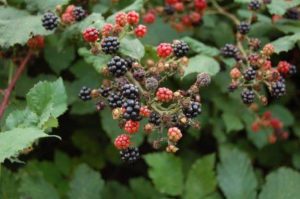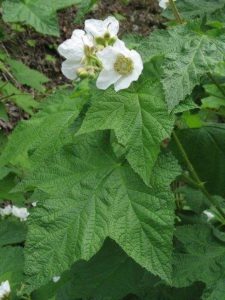This month’s weed is no stranger to anyone who’s spent much time in the Pacific northwest; whether you’ve been scratched by its prodigious thorns, gathered its fruit on a summer hike, or just driven by it on a country road, you’ve probably met Armenian blackberry (Rubus bifrons). Wait: Armenian? Isn’t it “Himalayan?” Well, yes and no. Luther Burbank–famed breeder of plants and (later) proponent of eugenics (talk about mission creep!)–first received seeds for the plant from a collector in India, and so dubbed it the “Himalaya Giant” in marketing it to unsuspecting growers in mild climates. This particular species of blackberry originates in the Caucasus region, however, so the “Armenian” epithet is gaining traction in the name of truth in advertising. (Even its Latin binomial is open to question, as the plant has variously been referred to as Rubus procerus, R. discolor, and R. armeniacus, in addition to R. bifrons.)
Whatever you call it, it isn’t shy. The vigor of its growth is the stuff of legend: thick canes an inch or more in diameter may reach over 20′ in length. Not content with this, the growing point of the cane–once in contact with moist soil–produces new roots, which give rise to additional canes (called “daughter plants”), resulting in the impenetrable thickets which occupy so many roadsides, hedgerows, and open fields in our region. The canes, as well as the alternate, compound leaves (each 7-20 cm across, consisting of 3 or 5 ovate leaflets) are famously armed with “thorns” (technically “prickles,” since they are derived from epidermal tissue…though that seems too innocuous a term, in light of the gouging they give one on contact). White or pink-tinged flowers are five-petaled and 2-2.5 cm across, and produce the plant’s eponymous dark berries in late summer, which even the most calloused restoration practitioner must grudgingly admit are not entirely unpalatable.
What’s to be done with it? For small populations, multiple pairs of gloves and persistent digging of the roots will control it; a vigilant watch for any re-sprouting from leftover roots and/or seeds helps, too. At larger scales, repeated cutting for many years can keep it at bay (though “many years” may translate to “until the end of all time”); cutting, followed by the application of an appropriate herbicide to the re-growing canes, is effective on a one- to two-year time frame (followed, again, by a watchful eye on the area). Re-planting controlled areas is helpful, as well, both to provide habitat for whatever animals may have made their home in the thicket and because blackberry is much less prolific in shade.
What to plant in its place? Armenian blackberry can grow in a wide array of habitats, so the choice of appropriate replacements will depend on the nature of the area and your goals for it. One native species that will thrive in a similar array of conditions is thimbleberry (Rubus parviflorus), which will also form dense (prickle-free!) thickets; its deep-red berries, while much less juicy than blackberries, are wonderfully flavorful, its showy white flowers are very attractive, and its fuzzy leaves make a good emergency toilet paper.
Images:

KoS, Wikimedia Commons (blackberry)

Robert Flogaus-Faust, Wikimedia Commons (thimbleberry)
